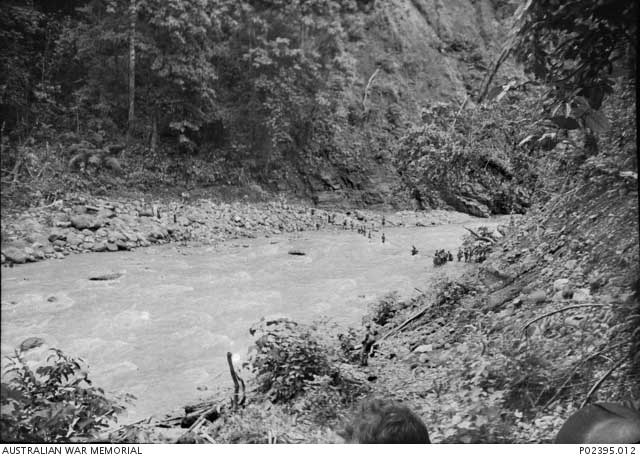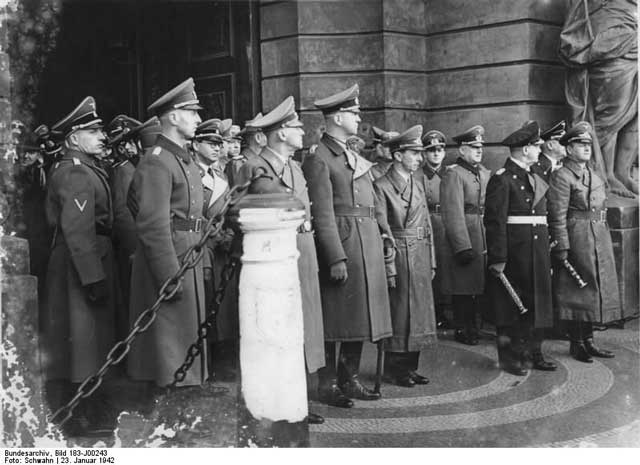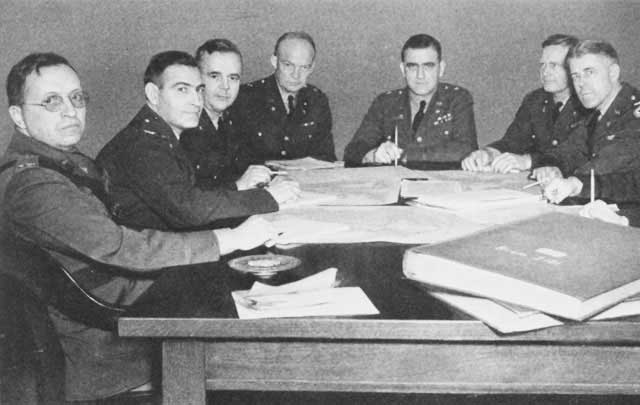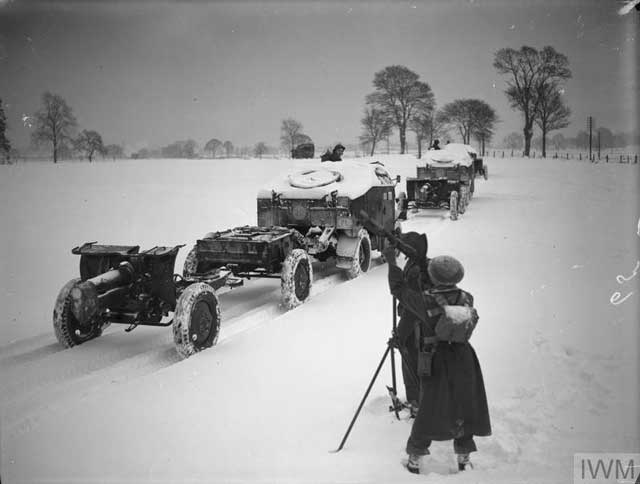Sunday 25 January 1942
 |
| "Fairey Fulmar planes grounded in the snow after a storm." Royal Naval Air Station Donibristle, 25 January 1942. © IWM (A 7252). |
Battle of the Pacific: Thailand, on 25 January 1942, declares war on the Allies, and Britain, New Zealand, and South Africa reciprocate. While Thailand does not have a particularly imposing military, it does have an extremely useful location for Japanese troops invading Burma. General Archibald Wavell, Commander in Chief Australian-British- Dutch-American (ABDA) Command, South West Pacific, flies to Rangoon and finds the situation deteriorating rapidly. The battle line is west of the Salween River, opposite Moulmein, and Wavell orders Moulmein held. The Japanese are bringing up reinforcements via Thailand, however, and the unit tasked with holding Moulmein, the 16th Brigade, Indian 17th Division, is overmatched and at best can delay the Japanese.
On the Malay Peninsula, Lieutenant General Arthur Percival meets with Generals Bennett and Heath. They decide to order a withdrawal by the troops at Buta Pahat back to Singapore. The British in any event are unable to hold Batu Pahat after furious battles during the day, including attempts to reinforce the garrison with the British 53rd Brigade Group. Indian 3 Corps begins pulling out of the area after dark. The Japanese focus their attack in the western portion of the line, and the 2/20th AIF Battalion evacuates Mersing to Jemaluang Crossroads.
In Borneo, the Japanese expand their hold at Balikpapan, where they already are in possession of the critical refinery. Their advance southward is slow because the Dutch garrison has destroyed the bridges on the main coastal road. Late in the day, the Japanese reach Balikpapan City, which the Dutch have abandoned. The Japanese send their Surprise Attack Unit south of the Reservoir and head upriver toward the village of Banoeabaroe. The remaining Dutch troops in the area attempt to withdraw via the coast road, but the Surprise Attack Unit cuts them off. After that, the Surprise Attack returns to Balikpapan City and helps to complete its occupation.
In the Philippines, the eastern half of the Allied line controlled by II Corps pulls back under pressure. I Corps, in control of the western half of the line, also pulls back and abandons its defenses at Mauban south of Moron (Morong). The Japanese roadblock on West Road behind the main front line continues to be a thorn in the I Corps side, and the US command has to divert additional troops to it from the west. The small Japanese bridgehead far to the south at Quinauan and Longoskawayan Points also holds out against fierce Allied attacks, though it is being forced back against some cliffs. It is a bitter battle, with heavy casualties on both sides. The retreat down the Bataan Peninsula has progressed so far now that the southern beach areas now shift from the control of the Service Command Area to the military commanders of I and II Corps.
Sailors in the Japanese Navy continue to feel invulnerable and use their submarines to take potshots at US military installations. on 25 January 1942, Japanese submarine I-73 shells the US base on Midway Island. Meanwhile, I-59 enters Sabang Roads, Sumatra (Indonesia) and sinks a freighter and captures part of the crew.
Battle of the Mediterranean: Panzer Group Africa continues its offensive and takes Msus. British 1st Armoured Division, 13 Corps, falls back on Mechili. Indian 4th Division evacuates Benghazi and Barce, protected by a small detachment of tanks from the 1st Armoured Division. British General Neal Ritchie, General Officer Commanding Eighth Army, then orders the Indian 4th Division and 1st Armoured Division to prepare a counterattack.
U-130 (KrvKpt. Ernst Kals) is on its second patrol out of Lorient. Today, it is operating off the coast of New Jersey and torpedoes and sinks 9305-ton Norwegian tanker Varanger. Everyone is rescued.
U-123 (Kptlt. Reinhard Hardegen) is on its seventh patrol out of Lorient. It was the first U-boat to reach the US east coast and now is on its way back to France. Today, in the mid-Atlantic, it uses its deck gun to attack and sink 3044-ton British freighter Culebra, which was dispersed from Convoy ON-53 and is en route from London/Loch Ewe to Bermuda/Jamaica. There are no survivors. Captain Hardegan praises the crew of the Culebra in his log, noting their "astonishing cold-bloodedness" as the Culebra's crew puts up a heroic fight with its deck gun.
U-754 (Kptlt. Hans Oestermann) is on its first patrol out of Kiel. Today, it torpedoes and sinks 3876-ton Greek collier Mount Kitheron about two miles off St. John's, Newfoundland and Labrador. There are 12 deaths and 24 survivors.
Eastern Front: The Red Army advance west of Moscow continues on 25 January 1942. The advancing Soviets encircle Kholm (south of Lake Ilmen). Isolated in the pocket are about 5500 German troops under the command of General Theodor Scherer, primarily of the 218th Infantry Division and the 553rd Regiment of the 329th Division, but with many other men from other units, too. Unlike in the larger Demyansk pocket nearby, there is not enough land for an airstrip, so all supplies must be air-dropped - which is hazardous for both the planes and the German soldiers who sometimes are enticed into going dangerously close to Soviet outposts to get the containers.
The Soviet troops are occupying vast swathes of territory during the Moscow counteroffensive, but it is not easy. They are struggling through snowdrifts and over icy roads, and the fact that they are encountering little opposition from the Wehrmacht, which is, for the most part, sitting tight in fortified towns, is cold comfort. Due to necessity, the Germans have adopted a strong-point strategy (also called a hedgehog defense) wherein they occupy isolated fortified towns and villages while basically conceding everywhere else to the Soviets. This has been put in motion not out of some kind of well-thought strategy, but because Hitler has ordered the troops to hold towns without regard to being surrounded. The hedgehog defense actually is very effective (it is "invented" by NATO in the 1970s), but flies in the face of 1942 military doctrine.
On the Crimea Peninsula, Soviet General Kozlov continues sending reinforcements by sea to his small bridgehead at Sudak, which is far behind the mainline. Kozlov is convinced that the Germans don't have the strength to eliminate the bridgehead, but German General Fretter-Pico already is diverting troops from 30 Corps which will soon be in a position to attack with devastating superiority.
Australian Government: The Australian War Cabinet calls up for military service "all able-bodied white male British subjects" between the ages of 18 and 45 years old.
1942
January 1942
January 1, 1942: Declaration By United Nations
January 2, 1941: Manila Falls to Japan
January 3, 1942: ABDA Command Announced
January 4, 1942: MacArthur on His Own in the Philippines
January 5, 1942: Soviets Plan General Offensive
January 6, 1942: US Army in Europe
January 7, 1942: Soviet General Offensive Opens
January 8, 1942: Hitler Sacks Hoepner
January 9, 1942: Battle of Dražgoše
January 10, 1942: Building the Jeep
January 11, 1942: Japan Takes Kuala Lumpur
January 12, 1941: Rommel Plans Counterattack
January 13, 1942: First Ejection Seat Use
January 14, 1942: Operation Drumbeat First Sinking
January 15, 1942: U-Boat Off NYC
January 16, 1942: Carole Lombard Crash
January 17, 1942: British Take Halfaya Pass
January 18, 1942: Soviet Paratroopers in Action
January 19, 1942: FDR Approves Atomic Bomb
January 20, 1942: The Wannsee Conference
January 21, 1942: Parit Sulong Bridge Battle
January 22, 1942: Parit Sulong Massacre
January 23, 1942: Japan Takes Rabaul
January 24, 1942: Battle of Makassar Strait
January 25, 1942: Kholm Surrounded
January 26, 1942: GIs Land in Europe
January 27, 1942: Battle of Endau
January 28, 1942: Rommel Takes Benghazi
January 29, 1942: First US Coast Guard Ship Sunk
January 30, 1942: Singapore Isolated
January 31, 1942: Army Group South Averts Disaster
2020
 |
| "Fairey Fulmar planes grounded in the snow after a storm." Royal Naval Air Station Donibristle, 25 January 1942. © IWM (A 7251). |
 |
| "Malaya. AIF artillerymen firing a 25 pounder gun from beside a rubber plantation." January 1942. Australian War Memorial 011303/30. |
 |
| The Richmond Times-Dispatch for 25 January 1942 has timely news about the Battle of the Makassar Strait, an American victory. |
 |
| "Warangoi River, New Britain. 1942-01. The Adler River, in the Bainings Mountains on the eastern side of the Gazelle Peninsula, an obstacle to the Australian troops retreating from Rabaul after the successful attack by Japanese forces. This is the point where at least two parties of retreating Australian troops crossed the Adler River. The first party of twenty-one men from the Anti-aircraft Battery Rabaul and the 17th Anti-tank Battery crossed here on 1942-01-26 securing a lawyer vine rope to cross the river. This image was taken in late January 1942 and shows some of the men of Sergeant L. I. H. (Les) Robbins' party fording the river as they make their way south toward Palmalmal Plantation and rescue in April 1942." The Japanese are in firm control of the port of Rabaul on 25 January 1942, but their grip on the rest of New Britain is tenuous. The retreating Australian troops have nowhere to go and little hope of rescue, but they can hide out in the jungles for as long as they can find food and water. Australian War Memorial P02395.012. |
 |
| Lieutenant General Erwin Rommel on an inspection tour of the front, January 1942 (Gemini, Ernst A., Federal Archive Figure 183-H26262). |
U-130 (KrvKpt. Ernst Kals) is on its second patrol out of Lorient. Today, it is operating off the coast of New Jersey and torpedoes and sinks 9305-ton Norwegian tanker Varanger. Everyone is rescued.
 |
| British freighter Culebra, sunk by U-123 on 25 January 1942. |
U-754 (Kptlt. Hans Oestermann) is on its first patrol out of Kiel. Today, it torpedoes and sinks 3876-ton Greek collier Mount Kitheron about two miles off St. John's, Newfoundland and Labrador. There are 12 deaths and 24 survivors.
 |
| German soldiers on the march in southern USSR, January 1942 (Grunewald, Federal Archive Picture 101I-539-0393-26A). |
 |
| Greek freighter Mount Kitheron, torpedoed off St. John's, Newfoundland, on 25 January 1942. |
 |
| German soldiers use sleds to unload a Junkers Ju 52 transport in the Demyansk pocket south of Lake Ilmen, January 1942 (Ullrich, Gerhard, Federal Archive Bild 101I-003-3446-21). |
 |
| Reichsmarschall Hermann Goering and Italian leader Benito Mussolini watch a demonstration of aircraft prototypes at Furbara Airfield, January 1942 (Federal Archive Picture 146-1979-155-22). |
 |
| "At the scene of the 'incident', telephone repair crews unroll new cables on a bomb-damaged London street in order to breach the gap in telephone supply caused by an air raid." London, January 1942 (© IWM (D 6445)). |
1942
January 1942
January 1, 1942: Declaration By United Nations
January 2, 1941: Manila Falls to Japan
January 3, 1942: ABDA Command Announced
January 4, 1942: MacArthur on His Own in the Philippines
January 5, 1942: Soviets Plan General Offensive
January 6, 1942: US Army in Europe
January 7, 1942: Soviet General Offensive Opens
January 8, 1942: Hitler Sacks Hoepner
January 9, 1942: Battle of Dražgoše
January 10, 1942: Building the Jeep
January 11, 1942: Japan Takes Kuala Lumpur
January 12, 1941: Rommel Plans Counterattack
January 13, 1942: First Ejection Seat Use
January 14, 1942: Operation Drumbeat First Sinking
January 15, 1942: U-Boat Off NYC
January 16, 1942: Carole Lombard Crash
January 17, 1942: British Take Halfaya Pass
January 18, 1942: Soviet Paratroopers in Action
January 19, 1942: FDR Approves Atomic Bomb
January 20, 1942: The Wannsee Conference
January 21, 1942: Parit Sulong Bridge Battle
January 22, 1942: Parit Sulong Massacre
January 23, 1942: Japan Takes Rabaul
January 24, 1942: Battle of Makassar Strait
January 25, 1942: Kholm Surrounded
January 26, 1942: GIs Land in Europe
January 27, 1942: Battle of Endau
January 28, 1942: Rommel Takes Benghazi
January 29, 1942: First US Coast Guard Ship Sunk
January 30, 1942: Singapore Isolated
January 31, 1942: Army Group South Averts Disaster
2020



























